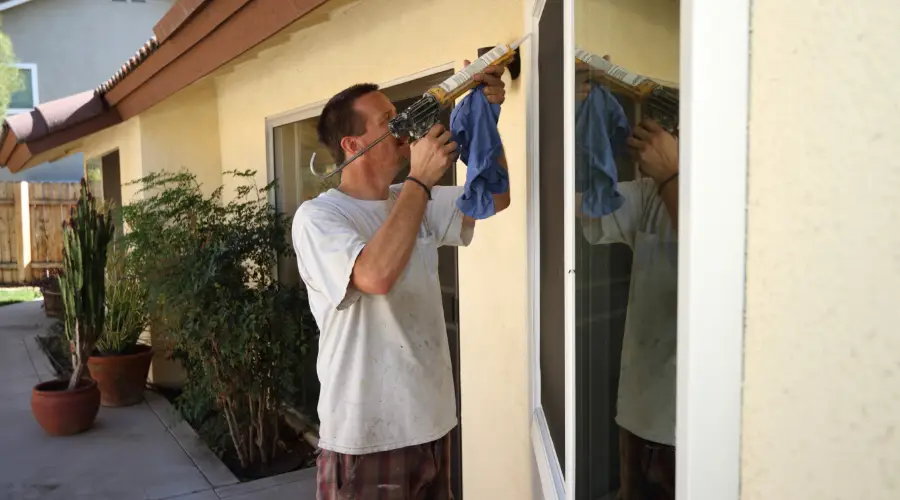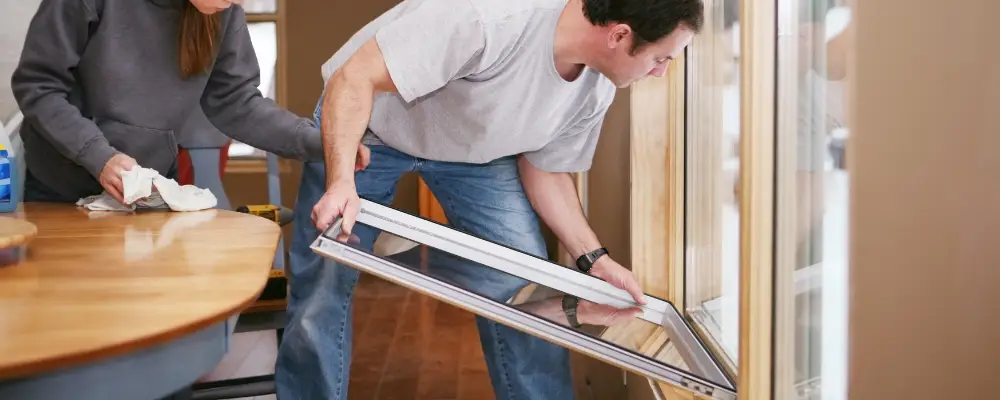Energy-efficient windows are a key component in reducing energy consumption and enhancing home comfort. By minimizing heat transfer, they help maintain stable indoor temperatures, cutting down on heating and cooling costs. These windows are designed with advanced technologies like double glazing, low-emissivity coatings, and insulating frames, offering both environmental benefits and long-term savings. In this blog, we’ll explore how energy-efficient windows can transform your home’s energy performance.
What are Energy Efficient Windows?

Energy-efficient windows are designed to provide high performance by decreasing the energy needed to heat and cool a building. These windows use advanced materials and technologies that increase insulation performance compared to conventional windows. They reduce energy loss and heat exchange- there are proven examples of the improvement of energy efficiency in homes, offices, and industrial buildings.
Functions of Energy-Efficient Windows
Energy-efficient windows have features that enable them to not just keep the heat in or out, but also perform the following functions:
- Thermal Insulation: Energy-efficient windows possess the feature of being able to resist the flow of thermal energy. The insulation ability of a window is measured by its U-value. The smaller the U-value, the better the window insulates against heat transfer. Therefore, air conditioners are not required for most of the summer and your house will be pleasantly warm even on the coldest of winter days by using such windows.
- Solar Control: These windows help in reducing sunlight-induced heat gain by reflecting or absorbing the sun’s infrared energy. Hence, the unpleasant situation of using air conditioners during the times of the year when the solar radiation is high does not arise. You further lower the use of electricity for the same equipment, thus still leading to lower bills during the month.
- Noise Reduction: Windows made up of several layers, with the gap filled with a special gas, help considerably in decreasing noise transmission. This is a great advantage especially if your house is in a place that experiences high vehicular traffic or you have noisy neighbours.
- UV Protection: Energy-efficient windows prevent harmful ultraviolet (UV) rays—which are highly destructive to human health as well as furniture, carpets, and artworks—from entering a space. This approach is a win-win when it comes to not only saving energy but also reducing the negative environmental effects of climate change.
How Do Energy-Efficient Windows Work?
Energy-efficient windows work by minimising heat transfer between the inside of the building and the outside. They function by using special elements like:
- Multiple Glazing Layers: Two or three panes make an insulating barrier that decreases heat transfer. The more the number of glass panes, the better the window can regulate the indoor temperature.
- Low-E Coatings: Low-E coatings are thin chemical coatings applied to the glass. These coatings reflect infrared light (heat) but allow favourable daylight inside. The ability to contain heat produced inside in winter and prevent heat generated outside from entering the house in summer is enabled by such coatings.
- Insulating Gas Fills: Often, gaseous fill materials are used to reduce heat flow between the panes of glass. Argon and krypton gas, the most common fill materials, are denser than air and are poor conductors of heat, thus improving insulation.
- Warm-Edge Spacers: These are insulating materials placed between glass panes to reduce heat loss at the edges where glass meets the frame or connects with other glass panes. Made from stainless steel, plastic, or composites, they enhance energy efficiency by preventing thermal bridging.
The result of these technologies is eco-friendly windows, creating a thermal barrier that does not allow the external weather conditions to affect the indoor temperature and ensuring the building typically does not require either heating or cooling systems.
Types of Energy-Efficient Windows
Double & Triple-Glazed Windows
Double-glazed windows are a popular choice for energy efficiency, featuring two glass panes with an insulating gap filled with argon gas or air. This design reduces heat transfer, improving thermal insulation and lowering energy costs, while also offering noise reduction. The panes are sealed together using spacers made of materials like aluminum, stainless steel, or plastic. Triple-glazed windows provide even better insulation with three panes of glass and two insulating gaps, further enhancing energy efficiency and noise control for a more comfortable home.
Low-E Glass Windows
Low-E (emissivity) glass windows are coated with a very thin layer of metal oxide that reflects infrared light but transmits visible light. The coating prevents heat from the exterior in summers and keeps the heat inside in winter. The low-E coating is produced in many types with varying amounts of reflectivity, so that people living in warmer climates can choose the type that provides the level of insulation that they desire.
Argon Gas-Filled Windows
Argon is a clear, odourless gas that is denser than air. This gas is used to fill the space between window panes to reduce heat transfer as it is a poor heat conductor. Argon gas is typically used in double-glazed and triple-glazed windows for insulation purposes. Argon windows are inexpensive, but very effective at improving energy efficiency.
Krypton Gas-Filled Windows
Like argon gas, Krypton gas is also used to fill the spacing between the panes of glass in windows. Krypton has higher density than Argon, which makes it more effective at insulating. Krypton gas-filled windows are an excellent choice when the window spacing is narrow and there is a need for maximum insulation. Krypton gas is more expensive than Argon, but its cost is compensated with a higher performance in windows.
Vacuum Insulated Windows
Vacuum-insulated windows offer some of the highest insulation levels available. There is little heat transfer because the vacuum between the panes creates an extremely low level of heat conductivity. These units are generally more expensive, and also tend to be more fragile than the other options, but the quality of their performance in extreme temperatures is unmatched.
Thermochromic Windows
Thermochromic windows have the ability to change their tint based on temperature. They can block excess solar radiation by darkening when temperatures rise. This capability may improve energy efficiency or enhance comfort by decreasing glare, especially in locations with significant amounts of direct sunlight.
Electrochromic (Smart) Windows
Electrochromic windows use a small electrical current to change the tint of the glass. When activated, the glass darkens to reduce glare and solar heat gain. This allows for real-time control of the window’s transparency, making it possible to adjust the amount of light and heat entering a room based on the user’s preferences.
Secondary Glazing & Types
Secondary glazing involves adding an additional pane of glass or transparent material to the interior of an existing window, offering an affordable solution for improving energy efficiency without replacing the entire window. Several options are available:
- Secondary Glazing Film: A thin plastic film that can be applied to existing glass panes, offering the least thermal benefits. It’s cost-effective but doesn’t last long and may not be aesthetically pleasing.
- Magnetic Secondary Glazing: Using magnetic strips or clip-fit systems, this option allows you to attach an additional pane to your window. It reduces heat loss and is easily removable for cleaning or replacement.
- Permanent Secondary Glazing: Custom-built frames made from wood or uPVC with glazing. Although more expensive, it provides better energy efficiency than window replacement and is ideal for properties with restrictions, such as listed buildings.
Secondary glazing can be a great way to enhance insulation and energy performance without the added expense of new windows.
Key Benefits of Energy-Efficient Windows
- Energy Savings: Energy-efficient windows not only cut down the demand for mechanical heating and cooling, but also result in significant money savings on utility bills. Property owners who are considering the purchase of energy-efficient windows can usually count on savings of at least 25% in their monthly heating and cooling costs. Energy-efficient windows are not only a wise financial decision that guarantees you substantial savings on your energy bills, but also an environment-friendly solution.
- Improved Comfort: Energy-efficient windows create consistent indoor temperatures, thus contributing to higher comfort by avoiding drafts and cold spots. In essence, energy-efficient windows will enhance comfort by ensuring the right temperature throughout the year.
- Environmental Impact: Energy-efficient windows help in reducing the carbon footprint of a building. Hence, they contribute to sustainable development and reduce pollution.
- Increased Property Value: Homes today have many things consumers are looking for in a property, and energy-efficient features are in high demand; including windows. Higher resale values may also be common as buyers are increasingly looking to reduce costs and utility bills with more energy-efficient windows.
- UV Protection: Energy-efficient windows with low-E coats and tints commonly block UV rays. This protects your interior from fading and protects your furniture, flooring, and artwork from degrading, thus contributing to longer-lasting products.
- Moisture Control: Energy-efficient windows help maintain consistent temperatures, reducing interior condensation. Choosing windows with a high rating is crucial for better moisture control, especially in colder climates.
- Noise Reduction: Double- or triple-pane windows not only enhance temperature regulation but also provide excellent soundproofing. Triple-pane glass offers superior noise reduction, and selecting windows with a high rating ensures optimal soundproofing along with energy efficiency.
How to Choose the Right Energy-Efficient Windows
Choosing the right energy-efficient window depends on several factors:
- Climate Zone: In colder climates, windows that insulate better are better options, like triple-glazed windows or windows with inert gas fills, like argon or krypton. In warmer climates, Low-E Glass is the option you would likely want because it has solar control properties. For weather conditions that oscillate between hot and cold, Low-E glass provides the full range of thermal control.
- Frame Material: Frame materials play an important role in energy efficiency because each material can insulate differently. The best insulators are wood or fibreglass materials. Aluminum framing can be energy efficient but only if there are thermal breaks or spacers because aluminum conducts heat.
- Performance Ratings: Make sure to always refer to National Fenestration Rating Council (NFRC) labels, U-values and the Solar Heat Gain Coefficient (SHGC) values. U-value shows how well a window insulates, and SHGC addresses the window’s ability to block solar heat.
- Installation: Even the best windows will under-perform if installed incorrectly, not for lack of a quality product but due to errors in sealing and fixing properly, leading to air leakage.
Conclusion
Energy-efficient windows can be a valuable investment decision for homeowners and businesses. Improved energy-efficiency, comfort, and lower environmental impact will ensure energy savings. Understanding the types of energy-efficient windows and the specific features will guide your decision making; particularly for your needs and the local climate condition.

